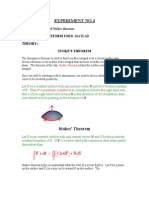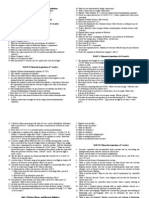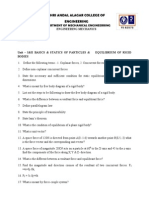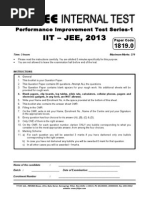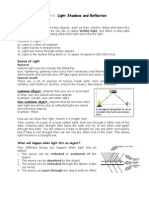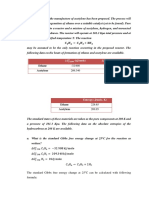Physics For Scientists & Engineers, With Modern Physics, 4 Edition
Uploaded by
Lucas RyanPhysics For Scientists & Engineers, With Modern Physics, 4 Edition
Uploaded by
Lucas Ryan1
Physics for Scientists &
Engineers, with Modern
Physics, 4
th
edition
Giancoli
Piri Reis University 2011-2012/ Physics -I
2
Piri Reis University 2011-2012 Fall Semester
Physics -I
Chapter 11
Angular Momentum
3
Piri Reis University 2011-2012
Lecture XI
I. L for Objects Rotating About a Fixed Axis
II. Vector Cross Product !or"ue as a Vector
III. L of a Partic#e
IV. L $ for a %yste& of Partic#es 'enera# (otion
V. L $ for a Rigid Object
VI. Conser)ation of Angu#ar (o&entu&
VII. !he %*inning !o* and 'yrosco*e
VIII. Rotating Fra&es of Reference Inertia# Forces
IX. !he Corio#is +ffect
,
I. Angular MomentumObjects Rotating About
a Fixed Axis
-inear (o&entu& .as defined as/
p = mv where p & v are vectors
!he rotationa# ana#og of #inear &o&entu& is angu#ar
&o&entu&/
L = Iwhere L & are vectors
0
I. Angular MomentumObjects Rotating About
a Fixed Axis
1e.ton2s second #a. for trans#ation .as/
F = dp/dt
!hen the rotationa# ana#og of 1e.ton2s second #a. is/
!his for& of 1e.ton2s second #a. is )a#id e)en if I is not
constant3
4
I. Angular MomentumObjects Rotating About
a Fixed Axis
In the absence of an externa# tor"ue5 angu#ar &o&entu& is
conser)ed/
(ore for&a##y5
the total angular momentum of a
rotating object remains constant if the
net external torque acting on it is zero
0 and constant.
dL
L I
dt
= = =
6
I. Angular MomentumObjects Rotating About
a Fixed Axis
!his &eans/
!herefore5 if an object2s &o&ent of inertia
changes5 its angu#ar s*eed changes as .e##3
7
Example 1: Object rotating on a string of
canging lengt.
A s&a## &ass m attached to the end of a string re)o#)es in
a circ#e on a friction#ess tab#eto*3
!he other end of the string *asses through a ho#e in the
tab#e3
Initia##y5 the &ass re)o#)es .ith a s*eed v
1
8 23, &9s in a
circ#e of radius R
1
8 :37: &3
;
Example 1: Object rotating on a string of
canging lengt.
Initia##y5 the &ass re)o#)es .ith a s*eed v
1
8 23, &9s in a
circ#e of radius R
1
8 :37: &3
!he string is then *u##ed s#o.#y through the ho#e so that
the radius is reduced to R
2
8 :3,7 &3 <hat is the s*eed5
v
2
5 of the &ass no.=
1:
Example 1: Object rotating on a string of
canging lengt.
>
Force on string in.ard creates tension and additiona#
centri*eta# force but no ?externa#@ tor"ue3
>
-ess &ass a distance fro& the ax#e &eans rotationa#
inertia is #ess AI 8 (r
2
B
> 1o externa# tor"ues 8C L conser)ed 8C I
1
1
8 I
2
2
=
constant
11
Example 1: Object rotating on a string of
canging lengt.
Dut it RO!A!+% fasterE %o .here does the force co&e to
acce#erate it=
And .on2t F+ ArotB 8 I
2
be #arger=
8C Gou HO .orI *u##ing it in.ards your force both *u##s it
for.ard and does .orI to increase F+3
12
Example !: "lutc.
A si&*#e c#utch consists of t.o cy#indrica# *#ates that
can be *ressed together to connect t.o sections of an
ax#e5 as needed5 in a *iece of &achinery3
!he t.o *#ates ha)e &asses M
A
8 43: Ig and
M
B
8 ;3: Ig5 .ith e"ua# radii R
0
8 :34: &3
!hey are initia##y se*arated3
P#ate M
A
is acce#erated fro& rest to an angu#ar )e#ocity
1
8 632 rad9s in ti&e t 8 23: s3
13
Example !: "lutc.
!he t.o *#ates ha)e &asses M
A
8 43: Ig and
M
B
8 ;3: Ig5 .ith e"ua# radii R
0
8 :34: &3
P#ate M
A
is acce#erated fro& rest to an angu#ar )e#ocity
1
8 632 rad9s in ti&e t 8 23: s3 Ca#cu#ate
AaB the angu#ar &o&entu& of M
A
5 and
AbB the tor"ue re"uired to ha)e acce#erated M
A
fro&
rest to
1
3
1,
Example !: "lutc.
!he t.o *#ates ha)e &asses M
A
8 43: Ig and
M
B
8 ;3: Ig5 .ith e"ua# radii R
0
8 :34: &3
P#ate M
A
is acce#erated fro& rest to an angu#ar )e#ocity
1
8 632 rad9s in ti&e t 8 23: s3 Ca#cu#ate
AaB the angu#ar &o&entu& of M
A
5
!he angu#ar &o&entu& is 637 IgJ&29s3
AbB the tor"ue re"uired to ha)e acce#erated M
A
fro&
rest to
1
3 !he tor"ue is the change in angu#ar
&o&entu& di)ided by the ti&e5 33; &J13
10
Example !: "lutc.
!he t.o *#ates ha)e &asses M
A
8 43: Ig and M
B
8 ;3:
Ig5 .ith e"ua# radii R
0
8 :34: &3 P#ate M
A
is
acce#erated fro& rest to an angu#ar )e#ocity
1
8 632
rad9s in ti&e t 8 23: s3
AcB 1ext5 *#ate M
B
5 initia##y at rest but free to rotate
.ithout friction5 is *#aced in fir& contact .ith free#y
rotating *#ate M
A
5 and the t.o *#ates both rotate at a
constant angu#ar )e#ocity
2
5 .hich is considerab#y
#ess than
1
3
<hy does this ha**en5 and .hat is
2
=
14
Example !: "lutc3
AcB 1ext5 *#ate M
B
5 initia##y at rest but free to rotate
.ithout friction5 is *#aced in fir& contact .ith free#y
rotating *#ate M
A
5 and the t.o *#ates both rotate at a
constant angu#ar )e#ocity
2
5 .hich is considerab#y
#ess than
1
3
<hy does this ha**en5 and .hat is
2
=
!his is a co##isionE Angu#ar &o&entu& is sti##
conser)ed5 if you define the ?syste&@ as both objects5
and then there is no externa# tor"ue in)o#)ed3 %o
I
1
1
8 I
2
2
16
Example #: $eutron star.
Astrono&ers detect stars that are rotating extre&e#y
ra*id#y5 Ino.n as neutron stars3 A neutron star is be#ie)ed
to for& fro& the inner core of a #arger star that co##a*sed5
under its o.n gra)itation5 to an object of )ery s&a## radius
and )ery high density3
Before collapse5 su**ose the core of such a star is the siKe
of our %un Ar L 6 x 1:
0
I&B .ith &ass 23: ti&es as great as
the %un5 and is rotating at a fre"uency of 13: re)o#ution
e)ery 1:: days3
17
Example #: $eutron star.
Defore co##a*se5 su**ose the core of such a star is the siKe
of our %un Ar L 6 x 1:
0
I&B .ith &ass 23: ti&es as great as
the %un5 and is rotating at a fre"uency of 13: re)o#ution
e)ery 1:: days3
If it .ere to undergo gra)itationa# co##a*se to a neutron star
of radius 1: I&5 .hat is its rotation fre"uency=
Assu&e the star is a unifor& s*here at a## ti&es5 and #oses
no &ass3
1;
Example #: $eutron star.
Defore co##a*se5 su**ose the core of such a star is the siKe
of our %un Ar L 6 x 1:
0
I&B .ith &ass 23: ti&es as great as
the %un5 and is rotating at a fre"uency of 13: re)o#ution
e)ery 1:: days3
If it .ere to undergo gra)itationa# co##a*se to a neutron star
of radius 1: I&5 .hat is its rotation fre"uency=
I
1
1
8 I
2
2
so
2
= I
1
1
/I
2
and I = 2/5 MR
2
As R oes do!n "y #$10
%
& I
2
oes do!n "y '5$10
(
And
2
oes UP "y 5$10
(
=) ' *00 revol+tions/second,
2:
I. Angular MomentumObjects Rotating About a Fixed Axis
Angu#ar &o&entu& is a )ector
for a sy&&etrica# object rotating
about a sy&&etry axis it is in the
sa&e direction as the angu#ar
)e#ocity )ector3
21
Example %: Running on a circular platform.
%u**ose a 4:-Ig *erson stands at the edge of a 43:-&-dia&eter
circu#ar *#atfor&5 .hich is &ounted on friction#ess bearings and has a
&o&ent of inertia of 17:: IgJ&
2
3 !he *#atfor& is at rest initia##y5 but
.hen the *erson begins running at a s*eed of ,32 &9s A.ith res*ect
to the +arthB around its edge5 the *#atfor& begins to rotate in the
o**osite direction3 Ca#cu#ate the angu#ar )e#ocity of the *#atfor&3
22
"onceptual Example &: 'pinning bic(cle )eel.
Gour *hysics teacher is ho#ding a s*inning
bicyc#e .hee# .hi#e he stands on a stationary
friction#ess turntab#e3
<hat .i## ha**en if the teacher sudden#y f#i*s
the bicyc#e .hee# o)er so that it is s*inning in
the o**osite direction=
23
II. *ector "ross +roduct, -or.ue as a *ector
!he )ector cross *roduct is defined as/
!he direction of the cross *roduct is defined by a right-hand
ru#e/
2,
II. *ector "ross +roduct, -or.ue as a *ector
!he cross *roduct can a#so be .ritten in deter&inant for&/
20
II.*ector "ross +roduct, -or.ue as a *ector
%o&e *ro*erties of the cross *roduct/
24
II. *ector "ross +roduct, -or.ue as a *ector
!or"ue can be defined as the )ector *roduct of the force and
the )ector fro& the *oint of action of the force to the axis of
rotation/
26
II. *ector "ross +roduct, -or.ue as a *ector
For a *artic#e5 the tor"ue can be defined around a *oint -/
Mere5 is the *osition )ector fro& the *artic#e re#ati)e to -3
r
r
27
Example /: -or.ue 0ector.
r
r
r
F
r
r
r
%u**ose the )ector is in the ! *#ane5 and is gi)en by 3
Ca#cu#ate the tor"ue )ector if 8 A10: 1B 3
8 A132 &B N 132 &
2;
III. Angular Momentum of a +article
!he angu#ar &o&entu& of a *artic#e about a s*ecified axis is
gi)en by/
3:
III. Angular Momentum of a +article
If .e taIe the deri)ati)e of 5 .e find/
%ince
.e ha)e/
r
1
31
III. Angular Momentum of a +article
"onceptual Example 2: A *artic#e2s angu#ar &o&entu&3
<hat is the angu#ar &o&entu& of a *artic#e of &ass m &o)ing .ith
s*eed v in a circ#e of radius r in a counterc#ocI.ise direction=
32
I*. Angular Momentum and -or.ue for a '(stem
of +articles, 3eneral Motion
!he angu#ar &o&entu& of a syste& of *artic#es can change
on#y if there is an externa# tor"ueOtor"ues due to interna#
forces cance#3
!his e"uation is )a#id in any inertia# reference fra&e3 It is a#so
)a#id for the center of &ass5 e)en if it is acce#erating/
33
*. Angular Momentum and -or.ue for a Rigid
Object
For a rigid object5 .e can sho. that its angu#ar &o&entu&
.hen rotating around a *articu#ar axis is gi)en by/
3,
Example 4: At)ood5s macine.
An At.ood &achine consists of t.o &asses5 m
A
and m
B
5
.hich are connected by an ine#astic cord of neg#igib#e
&ass that *asses o)er a *u##ey3 If the *u##ey has radius R
0
and &o&ent of inertia I about its ax#e5 deter&ine the
acce#eration of the &asses m
A
and m
B
5 and co&*are to
the situation .here the &o&ent of inertia of the *u##ey is
ignored3
30
"onceptual Example 6: 7ic(cle )eel.
%u**ose you are ho#ding a bicyc#e
.hee# by a hand#e connected to its
ax#e3 !he .hee# is s*inning ra*id#y
so its angu#ar &o&entu& *oints
horiKonta##y as sho.n3 1o. you
sudden#y try to ti#t the ax#e u*.ard
Aso the C( &o)es )ertica##yB3 Gou
ex*ect the .hee# to go u* Aand it
.ou#d if it .eren2t rotatingB5 but it
unex*ected#y s.er)es to the rightE
+x*#ain3
34
*. Angular Momentum and -or.ue for a Rigid
Object
A syste& that is rotationa##y
i&ba#anced .i## not ha)e its
angu#ar &o&entu& and angu#ar
)e#ocity )ectors in the sa&e
direction3 A tor"ue is re"uired to
Iee* an unba#anced syste&
rotating3
36
Example 18: -or.ue on unbalanced s(stem.
Heter&ine the &agnitude of the
net tor"ue "
net
needed to Iee* the
i##ustrated syste& turning3
37
*I. "onser0ation of Angular Momentum
If the net tor"ue on a syste& is constant5
!he total angular momentum of a system
remains constant if the net external torque
acting on the system is zero
3;
Example 11: 9epler5s second la) deri0ed.
Fe*#er2s second #a. states that each *#anet &o)es so that a #ine
fro& the %un to the *#anet s.ee*s out e"ua# areas in e"ua# ti&es3
Pse conser)ation of angu#ar &o&entu& to sho. this3
,:
Example 1!: 7ullet stri:es c(linder edge.
A bu##et of &ass m &o)ing .ith )e#ocity v striIes and
beco&es e&bedded at the edge of a cy#inder of &ass M
and radius R
0
3 !he cy#inder5 initia##y at rest5 begins to
rotate about its sy&&etry axis5 .hich re&ains fixed in
*osition3 Assu&ing no frictiona# tor"ue5 .hat is the angu#ar
)e#ocity of the cy#inder after this co##ision= Is Iinetic energy
conser)ed=
,1
*II. -e 'pinning -op and 3(roscope
A s*inning to* .i## *recess
around its *oint of contact .ith
a surface5 due to the tor"ue
created by gra)ity .hen its axis
of rotation is not )ertica#3
,2
*II. -e 'pinning -op and 3(roscope
!he angu#ar )e#ocity of the *recession is gi)en by/
!his is a#so the angu#ar )e#ocity of
*recession of a toy gyrosco*e5 as
sho.n3
,3
*III. Rotating Frames of Reference, Inertial
Forces
An inertia# fra&e of reference is one
in .hich 1e.ton2s #a.s ho#d a
rotating fra&e of reference is non-
inertial5 and objects )ie.ed fro&
such a fra&e &ay &o)e .ithout a
force acting on the&3
,,
*III. Rotating Frames of Reference, Inertial
Forces
!here is an a**arent out.ard force on objects in rotating
reference fra&es this is a fictitious force5 or a *seudoforce3 !he
centrifuga# ?force@ is of this ty*e there is no out.ard force .hen
)ie.ed fro& an inertia# reference fra&e3
,0
I;. -e "oriolis Effect
If an object is &o)ing in a
noninertia# reference fra&e5 there is
another *esudoforce on it5 as the
tangentia# s*eed does not increase
.hi#e the object &o)es farther fro&
the axis of rotation3 !his resu#ts in a
side.ays drift3
Inertial re.erence .ra/e
Rotatin re.erence .ra/e
,4
I;. -e "oriolis Effect
!he Corio#is effect is res*onsib#e
for the rotation of air around #o.-
*ressure areasO
counterc#ocI.ise in the 1orthern
Me&is*here and c#ocI.ise in the
%outhern3 !he Corio#is
acce#eration is/
,6
'ummar( of "apter ;I
> Angu#ar &o&entu& of a rigid object/
> 1e.ton2s second #a./
>Angu#ar &o&entu& is conser)ed3
>
!or"ue/
>
Angu#ar &o&entu& of a *artic#e/
>
1et tor"ue/
> If the net tor"ue is Kero5 the )ector angu#ar &o&entu& is conser)ed3
,7
<hat is the acce#eration of the &ass=
1o. .e can taIe into account the
rotation of the *u##ey=
)
r
&g
!
&a
(
r = radius
F = T
I =
1
2
Mr
2
=
a
r
F
y
= T mg = ma
r F = I
rT =
1
2
Mr
2
a
r
T =
Ma
2
Ma
2
mg = ma
a =
2mg
(M + 2m)
T =
Mm
(M + 2m)
,;
Friction#ess %ide.ays At.ood &achine
.ith a *u##ey .ith &ass
1o. taIe into account the rotation of the *u##ey3
a
ne.
e"uation
!
2
!
1
I 8 A!
2
-!
1
B R
Nx
-y
T
1
= Ma
T
2
mg = ma
I = (T
2
T
1
)R
a = R
1
2
MR
2
a
r
= (T
2
T
1
)R
1
2
MR
2
a
r
= (mg ma Ma)R
a =
m
m+
3
2
M
g
0:
1o. inc#ude friction bet.een b#ocI ( and
surface
a
!
2
!
1
I 8 A!
2
-!
1
B R
Nx
-y
T
1
Mg = Ma
T
2
mg = ma
I = (T
2
T
1
)R
a =R
1
2
MR
2
a
r
= (T
2
T
1
)R
1
2
MR
2
a
r
=
(mg ma Ma Mg)
R
a =
m(1 )
m+
3
2
M
g
01
<hat is the acce#eration of a s*here s&ooth#y
ro##ing do.n an inc#ined *#ane=
aB Hro* an object=
bB D#ocI s#iding do.n a
friction#ess inc#ined *#ane=
cB <ith friction=
dB %*here ro##ing do.n an
inc#ined
*#ane=
a
com
=
a = g
a = gsin
a = g(sin cos)
02
<hat is the acce#eration of a s*here s&ooth#y
ro##ing do.n an inc#ined *#ane=
x co&*onent 1e.tons
-a.
F
net
= Ma
com
f
s
Mgsin = Ma
com
net
8 I =
%o#)e for f
s
Rf
s
= I
com
=
a
com
R
Find tor"ue about the co&
03
a
com
=
gsin
1+
I
com
MR
2
!his .i## *redict .hich
objects .i## ro## do.n
the inc#ined faster3
f
s
= I
com
/ R
=
a
com
R
f
s
= I
com
a
com
/ R
2
I
com
a
com
/ R
2
Mgsin = Ma
com
%o#)e for
0,
shape I
com
1+ I
com
/MR
2
a
com
sphere 2/5 MR
2
1.4 0.71x g/2
disk 1/2MR
2
1.5 0.67 x g/2
pipe MR
2
2.0 0.50 x g/2
a
com
=
gsin
1+
I
com
MR
2
%in 3: 8 :30
-et 8 3: deg
00
HOM!O"#
$iancoli% Chapter 11
&% '% 1(% (&% ()% *(% *&% &+% &1% &)
"e,erences
o
0Physics For Scientists &Engineers with Modern Physics1 Giancoli %
t2
edition&
Pearson International 3dition
You might also like
- Matriculation Physics Electromagnetic InductionNo ratings yetMatriculation Physics Electromagnetic Induction96 pages
- DL/T 911-2004 (DL/T911-2004 DLT911-2004) - Translated English of Chinese Standard100% (4)DL/T 911-2004 (DL/T911-2004 DLT911-2004) - Translated English of Chinese Standard11 pages
- Coordinates, Graphs and Lines What Is Calculus??: Xa XBNo ratings yetCoordinates, Graphs and Lines What Is Calculus??: Xa XB12 pages
- Thin Aerofoil Theory: AE3010 Aerodynamics Lecture 2No ratings yetThin Aerofoil Theory: AE3010 Aerodynamics Lecture 259 pages
- Experiment 7: Uniform Circular Motion: PurposeNo ratings yetExperiment 7: Uniform Circular Motion: Purpose5 pages
- Elementary Linear Algebra First Canadian Edition Stewart Venit download pdf100% (1)Elementary Linear Algebra First Canadian Edition Stewart Venit download pdf67 pages
- 13S1 FE1073 C1-Resultants and Equilibrium of ForcesNo ratings yet13S1 FE1073 C1-Resultants and Equilibrium of Forces12 pages
- Flange Lateral Bending Stress Under Wind PressureNo ratings yetFlange Lateral Bending Stress Under Wind Pressure44 pages
- Experiment No.4: AIM:-Verification of Stokes Theorem Apparatus/Platform UsedNo ratings yetExperiment No.4: AIM:-Verification of Stokes Theorem Apparatus/Platform Used3 pages
- Determination by Simple Harmonic Motion of The Acceleration Due To GravityNo ratings yetDetermination by Simple Harmonic Motion of The Acceleration Due To Gravity7 pages
- Detection of Seepage Patterns Direction in The Bajulmati Dam, Banyuwangi, Indonesia Using Geoelectrical Method, Schlumberger and Dipole Dipole ConfigurationNo ratings yetDetection of Seepage Patterns Direction in The Bajulmati Dam, Banyuwangi, Indonesia Using Geoelectrical Method, Schlumberger and Dipole Dipole Configuration4 pages
- Shri Shankaracharya Group of Institutions B.E. - II Semester (Sec-I)No ratings yetShri Shankaracharya Group of Institutions B.E. - II Semester (Sec-I)3 pages
- Predictive Maintainance Using Thermal ImagingNo ratings yetPredictive Maintainance Using Thermal Imaging28 pages
- Optimized Design of Salient Pole Synchronous Generators: O.W. AndersenNo ratings yetOptimized Design of Salient Pole Synchronous Generators: O.W. Andersen3 pages
- Surya Group of Institution, Lucknow: Attempt All QuestionNo ratings yetSurya Group of Institution, Lucknow: Attempt All Question8 pages
- Chem 200: Short and Easy Test 2 Tuesday Dec 3, 2013No ratings yetChem 200: Short and Easy Test 2 Tuesday Dec 3, 20137 pages
- Pn-Junction Diode Characteristics: Mhlanga S 23721804 and Dlamini L.S 23772727 Experiment Done 22/ 07/ 2013No ratings yetPn-Junction Diode Characteristics: Mhlanga S 23721804 and Dlamini L.S 23772727 Experiment Done 22/ 07/ 201310 pages
- Continuous Comprehensive Evaluation Test-INo ratings yetContinuous Comprehensive Evaluation Test-I12 pages
- I Am Trying To Design A Bus Brace For A 3 Phase Busbar SyatemNo ratings yetI Am Trying To Design A Bus Brace For A 3 Phase Busbar Syatem9 pages
- Phys 101 - Midterm Exam: Student No Name SurnameNo ratings yetPhys 101 - Midterm Exam: Student No Name Surname6 pages
- Preparation of Papers For Indonesian Scholars Journal (February 2013)No ratings yetPreparation of Papers For Indonesian Scholars Journal (February 2013)3 pages
- Dokumen - Tips Atpl Pof Principles of Flight Questions BankNo ratings yetDokumen - Tips Atpl Pof Principles of Flight Questions Bank32 pages
- Department of Applied Physics: Final Year Project ReportNo ratings yetDepartment of Applied Physics: Final Year Project Report22 pages
- Divisional Contact: Dr. Reza Razeghifard, (954) 262-8333 Razeghif@nova - EduNo ratings yetDivisional Contact: Dr. Reza Razeghifard, (954) 262-8333 Razeghif@nova - Edu6 pages
- Networks of Communication and Exchange: 300 B.C.E. - 1100 C.ENo ratings yetNetworks of Communication and Exchange: 300 B.C.E. - 1100 C.E39 pages
- Topic101 (Physical Quantities Units Scientific Notation) With KeyNo ratings yetTopic101 (Physical Quantities Units Scientific Notation) With Key10 pages
- Journal of Molecular Structure: Yasushi Numata, Hayato Kobayashi, Norihiko Oonami, Yuki Kasai, Hiroyuki TanakaNo ratings yetJournal of Molecular Structure: Yasushi Numata, Hayato Kobayashi, Norihiko Oonami, Yuki Kasai, Hiroyuki Tanaka5 pages
- Check PV Componentsmaterials Compliancev 01182016No ratings yetCheck PV Componentsmaterials Compliancev 0118201679 pages
- Uop HF Alkylation Technology: Kurt A. Detrick, James F. Himes, Jill M. Meister, and Franz-Marcus NowakNo ratings yetUop HF Alkylation Technology: Kurt A. Detrick, James F. Himes, Jill M. Meister, and Franz-Marcus Nowak24 pages
- Ucsi University B.Eng (Hons) in Chemical Engineering Course OutlineNo ratings yetUcsi University B.Eng (Hons) in Chemical Engineering Course Outline2 pages
- Column Selection in HPLC Method DevelopmentNo ratings yetColumn Selection in HPLC Method Development38 pages
- Cambridge International General Certificate of Secondary EducationNo ratings yetCambridge International General Certificate of Secondary Education16 pages
- An Introduction To Rogers PCB and Rogers MaterialsNo ratings yetAn Introduction To Rogers PCB and Rogers Materials17 pages
- DL/T 911-2004 (DL/T911-2004 DLT911-2004) - Translated English of Chinese StandardDL/T 911-2004 (DL/T911-2004 DLT911-2004) - Translated English of Chinese Standard
- Coordinates, Graphs and Lines What Is Calculus??: Xa XBCoordinates, Graphs and Lines What Is Calculus??: Xa XB
- Thin Aerofoil Theory: AE3010 Aerodynamics Lecture 2Thin Aerofoil Theory: AE3010 Aerodynamics Lecture 2
- Elementary Linear Algebra First Canadian Edition Stewart Venit download pdfElementary Linear Algebra First Canadian Edition Stewart Venit download pdf
- 13S1 FE1073 C1-Resultants and Equilibrium of Forces13S1 FE1073 C1-Resultants and Equilibrium of Forces
- Experiment No.4: AIM:-Verification of Stokes Theorem Apparatus/Platform UsedExperiment No.4: AIM:-Verification of Stokes Theorem Apparatus/Platform Used
- Determination by Simple Harmonic Motion of The Acceleration Due To GravityDetermination by Simple Harmonic Motion of The Acceleration Due To Gravity
- Detection of Seepage Patterns Direction in The Bajulmati Dam, Banyuwangi, Indonesia Using Geoelectrical Method, Schlumberger and Dipole Dipole ConfigurationDetection of Seepage Patterns Direction in The Bajulmati Dam, Banyuwangi, Indonesia Using Geoelectrical Method, Schlumberger and Dipole Dipole Configuration
- Shri Shankaracharya Group of Institutions B.E. - II Semester (Sec-I)Shri Shankaracharya Group of Institutions B.E. - II Semester (Sec-I)
- Optimized Design of Salient Pole Synchronous Generators: O.W. AndersenOptimized Design of Salient Pole Synchronous Generators: O.W. Andersen
- Surya Group of Institution, Lucknow: Attempt All QuestionSurya Group of Institution, Lucknow: Attempt All Question
- Chem 200: Short and Easy Test 2 Tuesday Dec 3, 2013Chem 200: Short and Easy Test 2 Tuesday Dec 3, 2013
- Pn-Junction Diode Characteristics: Mhlanga S 23721804 and Dlamini L.S 23772727 Experiment Done 22/ 07/ 2013Pn-Junction Diode Characteristics: Mhlanga S 23721804 and Dlamini L.S 23772727 Experiment Done 22/ 07/ 2013
- I Am Trying To Design A Bus Brace For A 3 Phase Busbar SyatemI Am Trying To Design A Bus Brace For A 3 Phase Busbar Syatem
- Preparation of Papers For Indonesian Scholars Journal (February 2013)Preparation of Papers For Indonesian Scholars Journal (February 2013)
- Dokumen - Tips Atpl Pof Principles of Flight Questions BankDokumen - Tips Atpl Pof Principles of Flight Questions Bank
- Department of Applied Physics: Final Year Project ReportDepartment of Applied Physics: Final Year Project Report
- The Science and Design of the Hybrid Rocket EngineFrom EverandThe Science and Design of the Hybrid Rocket Engine
- Divisional Contact: Dr. Reza Razeghifard, (954) 262-8333 Razeghif@nova - EduDivisional Contact: Dr. Reza Razeghifard, (954) 262-8333 Razeghif@nova - Edu
- Networks of Communication and Exchange: 300 B.C.E. - 1100 C.ENetworks of Communication and Exchange: 300 B.C.E. - 1100 C.E
- Topic101 (Physical Quantities Units Scientific Notation) With KeyTopic101 (Physical Quantities Units Scientific Notation) With Key
- Journal of Molecular Structure: Yasushi Numata, Hayato Kobayashi, Norihiko Oonami, Yuki Kasai, Hiroyuki TanakaJournal of Molecular Structure: Yasushi Numata, Hayato Kobayashi, Norihiko Oonami, Yuki Kasai, Hiroyuki Tanaka
- Uop HF Alkylation Technology: Kurt A. Detrick, James F. Himes, Jill M. Meister, and Franz-Marcus NowakUop HF Alkylation Technology: Kurt A. Detrick, James F. Himes, Jill M. Meister, and Franz-Marcus Nowak
- Ucsi University B.Eng (Hons) in Chemical Engineering Course OutlineUcsi University B.Eng (Hons) in Chemical Engineering Course Outline
- Cambridge International General Certificate of Secondary EducationCambridge International General Certificate of Secondary Education
- An Introduction To Rogers PCB and Rogers MaterialsAn Introduction To Rogers PCB and Rogers Materials



















